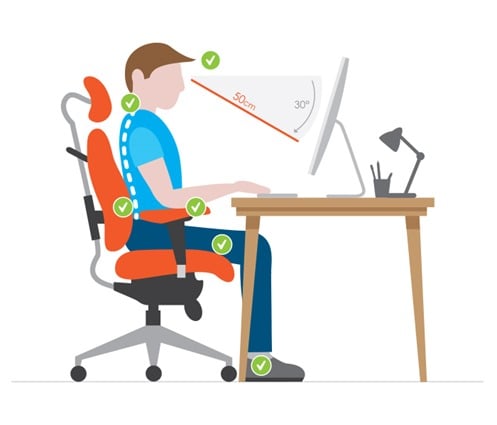In our modern, often sedentary work environments—whether in a bustling office or your cozy home setup—adopting thoughtful ergonomic habits can transform your day. At DeskZen, we believe that a well-designed ergonomic desk setup and mindful movement not only safeguard your health but also enhance focus, comfort, and long-term productivity. These tip and habits can easily be adopted either at home or at your workplace just with few adjustments. Feel free to give them a try !

1. Creating Your Ideal Workspace
Let’s review together what we know about ergonomic desk setup knowledge as off today :
1.1 Chair Positioning for Lasting Comfort

- Adjust Seat Height: Align your feet flat on the floor or on a supportive footrest. Aim for a 90°–110° angle at the knees, allowing blood flow and reducing fatigue.
- Support the Lumbar Curve: Position the chair’s lower-back support to mirror your spine’s natural curve. If your chair lacks built-in support, use a plush lumbar cushion or rolled towel.
- Balance Seat Depth & Backrest: Ensure two to three fingers’ space between your knees and the seat edge. Your upper and lower back should rest gently against the backrest without strain.
1.2 Nurturing Your Arms and Shoulders
- Elbow Alignment: Keep elbows close to your torso at a relaxed 90°–100° angle. This prevents shoulder tension and wrist strain.
- Armrest Fine-Tuning: Adjust armrests so your shoulders stay soft and relaxed. If resting on armrests causes your elbows to lift, lower them or remove arm supports entirely.
1.3 Keyboard & Mouse: Precision Placement
- Keyboard Height & Tilt: Place your keyboard at or slightly below elbow height. A slight negative tilt (front lower than back) maintains a neutral wrist posture.
- Mouse Accessibility: Position the mouse adjacent to the keyboard within easy reach. Consider a gel-padded mouse pad to cushion your wrist and guide fluid movements.
To optimize your workspace peripherals, be sure to explore our in-depth review of the Best Keyboard/Mouse for Office Use for comfort and efficiency.
1.4 Optimizing Your Monitor Setup
- Eye-Level Alignment: Center the top of your monitor at or just below eye level. Your gaze should naturally descend about 15°–20° toward the screen’s midpoint.
- Ideal Viewing Distance: Maintain 50–70 cm (an arm’s length) between eyes and screen. Adjust based on display size, text size, and personal comfort.
- Multi-Screen Strategy: For dual displays, balance them symmetrically or position the primary screen directly ahead, with the secondary angled gently beside it.
2. Cultivating Healthy Work Rituals
2.1 The 20‑20‑20 Rule: Soothing Tired Eyes
Every 20 minutes, look at an object at least 6 meters away for 20 seconds. This simple pause reduces digital eye strain, blinks more often, and refreshes focus.
2.2 Intentional Movement & Microbreaks
- Regular Standing Intervals: Aim to stand, stretch, or walk for 2–3 minutes every 30–45 minutes. Use gentle reminders or a sit-stand desk to shift between postures.
- Lower-Body Stretches: Perform seated leg extensions, calf raises, and ankle circles to boost circulation and ease stiffness.
- Upper-Body Mobility: Gently roll shoulders backward and forward, tilt your head side to side, and interlace fingers behind your head for a gentle back stretch.
2.3 Posture Checkpoints
Set an hourly reminder to realign:
- Feet flat and grounded.
- Spine gently supported by the chair’s back.
- Shoulders softened, not hunched.
- Wrists straight, elbows relaxed.
3. Telework: Maintaining Boundaries & Balance
- Designated Work Nook: Carve out a defined workspace—away from relaxation zones—to prime your mind for focus.
- Structured Routine: Begin and end each day at consistent times. Integrate planned breaks, and honor your personal “closing time.”
- Invest in Ergonomic Tools: Elevate your laptop with a stand, pair it with an external keyboard and ergonomic mouse, and choose a supportive office chair.
- Mindful Activity Breaks: Weave in brief yoga flows, brisk hallway walks, or breathing exercises to invigorate your body and calm your mind.
4. Advanced Tips & Resources
- Hydration & Nutrition: Keep a water bottle within reach and opt for balanced snacks (nuts, fruits) to maintain energy and concentration.
- Ambient Environment: Soften harsh lighting with diffused lamps, add houseplants for air quality, and control noise with headphones or white-noise machines.
- Further Reading: For a curated selection of the best office seats, explore our Top 10 Office Chairs and elevate your seating choice.
- External Insight: Learn more about ergonomic desk setup from the Occupational Safety and Health Administration (OSHA) to ensure compliance and deeper understanding.
Conclusion for an ergonomic desk setup
By intentionally designing your workspace and embracing microbreaks, you nurture both your physical well-being and mental clarity. At DeskZen, our mission is to help you craft an ergonomic desk setup environment that feels as good as it looks—promoting sustainable comfort, preventing discomfort, and supporting your productivity journey.
Discover more ergonomic wisdom and handpicked product recommendations to transform your desk into a sanctuary of focus and ease at DeskZen.

Leave a Reply